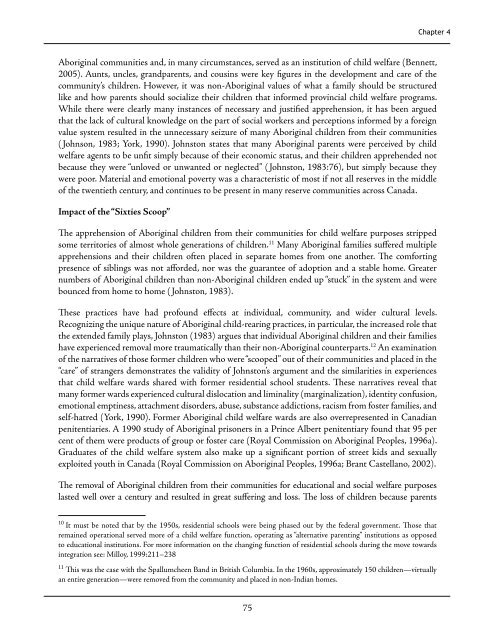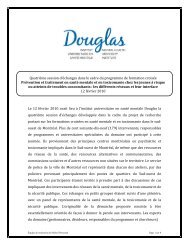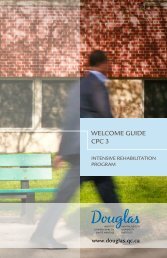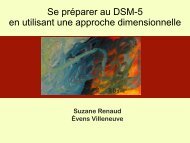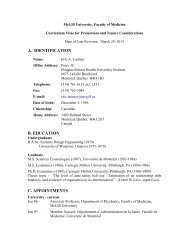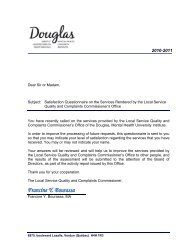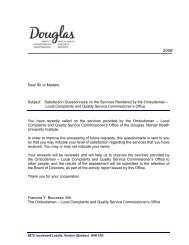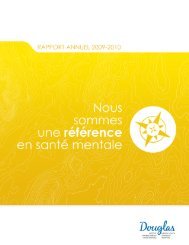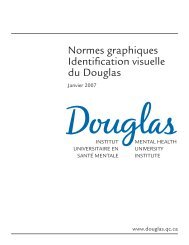Suicide Among Aboriginal People in Canada - Institut universitaire ...
Suicide Among Aboriginal People in Canada - Institut universitaire ...
Suicide Among Aboriginal People in Canada - Institut universitaire ...
Create successful ePaper yourself
Turn your PDF publications into a flip-book with our unique Google optimized e-Paper software.
Chapter 4<strong>Aborig<strong>in</strong>al</strong> communities and, <strong>in</strong> many circumstances, served as an <strong>in</strong>stitution of child welfare (Bennett,2005). Aunts, uncles, grandparents, and cous<strong>in</strong>s were key figures <strong>in</strong> the development and care of thecommunity’s children. However, it was non-<strong>Aborig<strong>in</strong>al</strong> values of what a family should be structuredlike and how parents should socialize their children that <strong>in</strong>formed prov<strong>in</strong>cial child welfare programs.While there were clearly many <strong>in</strong>stances of necessary and justified apprehension, it has been arguedthat the lack of cultural knowledge on the part of social workers and perceptions <strong>in</strong>formed by a foreignvalue system resulted <strong>in</strong> the unnecessary seizure of many <strong>Aborig<strong>in</strong>al</strong> children from their communities( Johnson, 1983; York, 1990). Johnston states that many <strong>Aborig<strong>in</strong>al</strong> parents were perceived by childwelfare agents to be unfit simply because of their economic status, and their children apprehended notbecause they were “unloved or unwanted or neglected” ( Johnston, 1983:76), but simply because theywere poor. Material and emotional poverty was a characteristic of most if not all reserves <strong>in</strong> the middleof the twentieth century, and cont<strong>in</strong>ues to be present <strong>in</strong> many reserve communities across <strong>Canada</strong>.Impact of the “Sixties Scoop”The apprehension of <strong>Aborig<strong>in</strong>al</strong> children from their communities for child welfare purposes strippedsome territories of almost whole generations of children. 11 Many <strong>Aborig<strong>in</strong>al</strong> families suffered multipleapprehensions and their children often placed <strong>in</strong> separate homes from one another. The comfort<strong>in</strong>gpresence of sibl<strong>in</strong>gs was not afforded, nor was the guarantee of adoption and a stable home. Greaternumbers of <strong>Aborig<strong>in</strong>al</strong> children than non-<strong>Aborig<strong>in</strong>al</strong> children ended up “stuck” <strong>in</strong> the system and werebounced from home to home ( Johnston, 1983).These practices have had profound effects at <strong>in</strong>dividual, community, and wider cultural levels.Recogniz<strong>in</strong>g the unique nature of <strong>Aborig<strong>in</strong>al</strong> child-rear<strong>in</strong>g practices, <strong>in</strong> particular, the <strong>in</strong>creased role thatthe extended family plays, Johnston (1983) argues that <strong>in</strong>dividual <strong>Aborig<strong>in</strong>al</strong> children and their familieshave experienced removal more traumatically than their non-<strong>Aborig<strong>in</strong>al</strong> counterparts. 12 An exam<strong>in</strong>ationof the narratives of those former children who were “scooped” out of their communities and placed <strong>in</strong> the“care” of strangers demonstrates the validity of Johnston’s argument and the similarities <strong>in</strong> experiencesthat child welfare wards shared with former residential school students. These narratives reveal thatmany former wards experienced cultural dislocation and lim<strong>in</strong>ality (marg<strong>in</strong>alization), identity confusion,emotional empt<strong>in</strong>ess, attachment disorders, abuse, substance addictions, racism from foster families, andself-hatred (York, 1990). Former <strong>Aborig<strong>in</strong>al</strong> child welfare wards are also overrepresented <strong>in</strong> Canadianpenitentiaries. A 1990 study of <strong>Aborig<strong>in</strong>al</strong> prisoners <strong>in</strong> a Pr<strong>in</strong>ce Albert penitentiary found that 95 percent of them were products of group or foster care (Royal Commission on <strong>Aborig<strong>in</strong>al</strong> <strong>People</strong>s, 1996a).Graduates of the child welfare system also make up a significant portion of street kids and sexuallyexploited youth <strong>in</strong> <strong>Canada</strong> (Royal Commission on <strong>Aborig<strong>in</strong>al</strong> <strong>People</strong>s, 1996a; Brant Castellano, 2002).The removal of <strong>Aborig<strong>in</strong>al</strong> children from their communities for educational and social welfare purposeslasted well over a century and resulted <strong>in</strong> great suffer<strong>in</strong>g and loss. The loss of children because parents10It must be noted that by the 1950s, residential schools were be<strong>in</strong>g phased out by the federal government. Those thatrema<strong>in</strong>ed operational served more of a child welfare function, operat<strong>in</strong>g as “alternative parent<strong>in</strong>g” <strong>in</strong>stitutions as opposedto educational <strong>in</strong>stitutions. For more <strong>in</strong>formation on the chang<strong>in</strong>g function of residential schools dur<strong>in</strong>g the move towards<strong>in</strong>tegration see: Milloy, 1999:211–23811This was the case with the Spallumcheen Band <strong>in</strong> British Columbia. In the 1960s, approximately 150 children—virtuallyan entire generation—were removed from the community and placed <strong>in</strong> non-Indian homes.75


